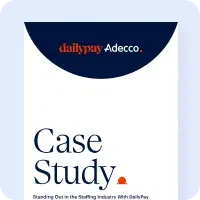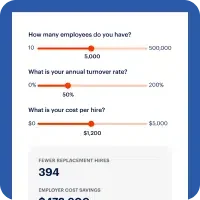Education Series Module 2: The Real Costs of On-Demand Pay
The Real Costs of On-Demand Pay
Breaking down the hard and soft costs of implementing and maintaining an on-demand pay solution.
Ready to get started with on-demand pay?
At a Glance
Education is key when choosing an on-demand pay vendor. Consider the costs associated with implementing and maintaining the solution and decide which vendor is best for your business and employees.
- There are potential hard costs and softs cost when implementing on-demand pay. Understand how these will impact your business.
- Consider how the vendor makes money. Is revenue tied to transaction fees, subscription fees, or another source?
- Check out our interactive calculator to see how much money employee turnover costs your business.
Many companies that want to improve their benefits packages and their employee experience have a limited budget to work with and want the highest return on investment possible.
Enter on-demand pay.
While many on-demand pay vendors may advertise their technology as free to the employer, there may still be costs to consider.
In this lesson, you’ll learn what “free” or “free to the employer” really means, the hard and soft costs of implementation, and how various on-demand pay models make their money.
What Does “Free” Really Mean?
We all know that few things in business are truly free, and on-demand pay solutions are no different. Each on-demand pay model has both hard and soft costs to consider, as details may differ from one vendor to another. It’s important to dig in and educate yourself to make an informed decision about which cost structure will work best for you and your employees.
For some on-demand pay vendors, “free” often refers to the absence of fees charged to the employer and/or employee.
However, businesses must consider soft costs such as additional workload, implementation time, and payroll support as they may be more expensive than the fees themselves.
Depending on the model, the responsibility of the fees may fall onto the employer or the employee. Many employers choose not to fund an additional benefit for their employees. On the other hand, solutions with excessive costs to employees may prevent them from enrolling.
Get the Numbers
High employee turnover is costly to your business. Studies have shown that companies with unhappy employees are 21% less profitable and disengaged employees can cost U.S. employers up to $550 billion per year.
Training, onboarding, and other costs can quickly add up. See exactly how much employee turnover is costing your company with this interactive calculator.
How many employees do you have?
What is your annual turnover rate?
Cost per new hire
fewer replacement hires
0
employer cost savings
0
Disclaimer: Calculations based on assumptions and annualized averages
The Real Costs of On-Demand Pay Solutions
Cost-related questions are first and foremost when considering new benefits. Let’s explore the possible hard and soft costs associated with on-demand pay providers.
Potential Hard Costs
For Employers
Implementation fees
Upgrade maintenance support
Employee support and education
Usage fees
For Employees
Transaction fees
Subscription fees
“Tips” for transactions
Potential Soft Costs
- HR support costs, including time to address employee questions and complaints
- Payroll support costs when there are questions about paycheck anomalies
- IT support costs for technical questions
- Implementation time from HR, Payroll, and IT
- Ongoing payroll management time requirements
- Employee communications, enrollment management, and onboarding
- Regulatory and compliance cost implications and risk
Make sure to ask potential providers about these costs in order to get a more accurate view of what it will actually cost to implement, offer and maintain this technology.
Each Model Makes Money Differently
Another important element to consider when choosing an on-demand pay provider is how the provider makes money. Although a particular provider may have no hard costs to the employer, there may be many fees to the employee.
While payday lenders make their money from high-interest rates and fees, on-demand pay providers tend to charge a nominal subscription fee, transaction fee, or merchant fee. It’s important to have all the facts when choosing the best fit for you and your business.
This table illustrates how various vendor models are funded and considerations for each:
Model
Revenue source
Vendor example
Digital on-demand pay
Transaction fee
Subscription fee
DailyPay
Even
Proprietary HCM
Bundled subscription
Merchant fees
Ceridian
Paylocity
Card solutions (Pay card/neobank)
Merchant fees
Sometimes also fees per transaction
Branch
Payactiv
Instant
Direct-to-consumer
Users required to ‘tip’ for service or pay interest
Dave
Earnin
Sample RFP Questions
When considering partnering with an on-demand pay provider, it’s critical to holistically evaluate each solution you’re considering in order to make the most educated selection. Thoroughly assessing the product experience for employees and employers, as well as security, privacy, and compliance for each solution will help you choose the best solution for your company.
Questions to consider asking based on the teachings in this module are:
- As the vendor, how are you paid back?
- What are the upfront costs associated with implementation?
- How does the fee structure work and what are the costs to employees?
Receive the Sample On-Demand Pay RFP
Thank You for Submission
Thank you.
We will get back to you soon to schedule your demo.
Thank you for your interest in the On-Demand Pay International Council!
We will get back to you in 2-3 business days.
Infographic

On-Demand Pay: The Real Cost of On-Demand Pay
Module 3

Implementing & Managing On-Demand Pay Solutions












